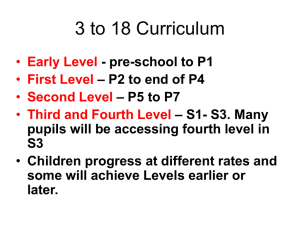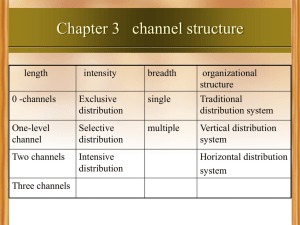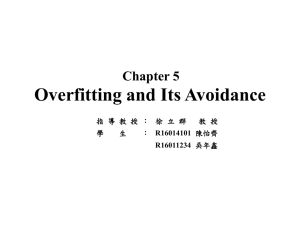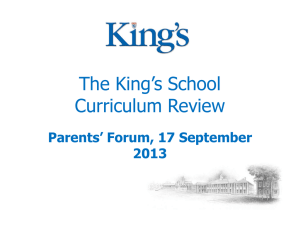tree classifiers from Pang
advertisement
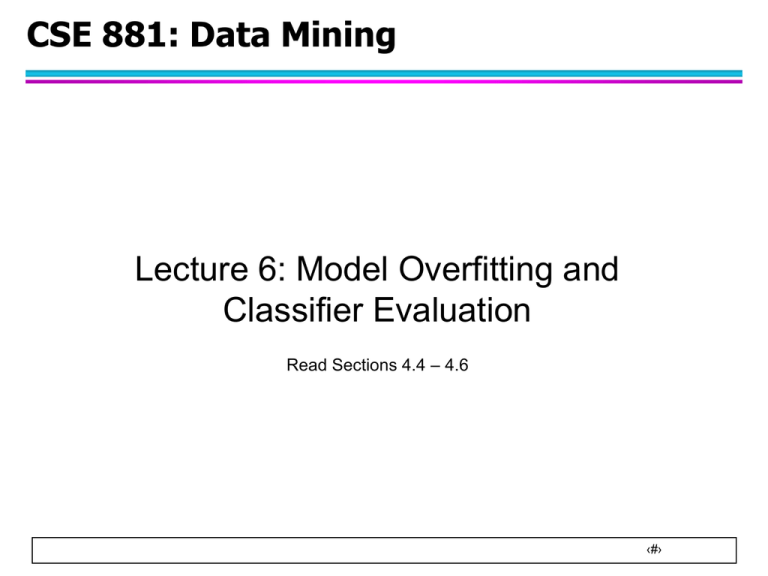
CSE 881: Data Mining
Lecture 6: Model Overfitting and
Classifier Evaluation
Read Sections 4.4 – 4.6
‹#›
Classification Errors
Training errors (apparent errors)
– Errors committed on the training set
Test errors
– Errors committed on the test set
Generalization errors
– Expected error of a model over random
selection of records from same distribution
‹#›
Example Data Set
Two class problem:
+, o
3000 data points (30% for
training, 70% for testing)
Data set for + class is
generated from a uniform
distribution
Data set for o class is
generated from a mixture
of 3 gaussian
distributions, centered at
(5,15), (10,5), and (15,15)
‹#›
Decision Trees
x2 < 17.35
x1 < 13.29
x2 < 12.63
x1 < 2.15
x1 < 6.56
x2 < 19.93
x2 < 17.35
x1 < 13.29
x1 < 7.24
x2 < 8.64
x1 < 2.15
x1 < 6.56
x1 < 3.03
x2 < 1.38
x1 < 2.72
x2 < 8.64
x1 < 12.11
x1 < 6.78
x2 < 12.68
x1 < 18.88
x2 < 4.06
x1 < 7.24
x1 < 6.99
x1 < 12.11
x2 < 1.38
x2 < 15.77
x2 < 17.14
x2 < 12.89
x2 < 13.80
x1 < 18.88
x2 < 16.75
x2 < 16.33
Decision Tree with 11 leaf nodes
Decision Tree with 24 leaf nodes
Which tree is better?
‹#›
Model Overfitting
Underfitting: when model is too simple, both training and test errors are large
Overfitting: when model is too complex, training error is small but test error is large
‹#›
Mammal Classification Problem
Body
Temperature
Cold
Warm
Training Set
Nonmammals
Give Birth
Yes
No
Mammals
Nonmammals
Decision Tree Model
training error = 0%
‹#›
Effect of Noise
Example: Mammal Classification problem
Body
Temperature
Training Set:
Warm-blooded
Cold-blooded
Yes
No
Fourlegged
Nonmammals
Test Set:
Mammals
train err = 0%,
test err = 30%
Nonmammals
Give Birth
Yes
Model M1:
No
Body
Temperature
Nonmammals
Cold-blooded
Warm-blooded
Model M2:
Nonmammals
Give Birth
train err = 20%,
test err = 10%
Yes
No
Mammals
Nonmammals
‹#›
Lack of Representative Samples
Training Set:
Body
Temperature
Cold-blooded
Warm-blooded
Nonmammals
Hibernates
Yes
No
Nonmammals
Fourlegged
Test Set:
Yes
No
Mammals
Nonmammals
Model M3:
train err = 0%,
test err = 30%
Lack of training records at the
leaf nodes for making reliable
classification
‹#›
Effect of Multiple Comparison Procedure
Consider the task of predicting whether
stock market will rise/fall in the next 10
trading days
Random guessing:
P(correct) = 0.5
Make 10 random guesses in a row:
10 10 10
8 9 10
P(# correct 8)
0.0547
10
2
Day 1
Up
Day 2
Down
Day 3
Down
Day 4
Up
Day 5
Down
Day 6
Down
Day 7
Up
Day 8
Up
Day 9
Up
Day 10 Down
‹#›
Effect of Multiple Comparison Procedure
Approach:
– Get 50 analysts
– Each analyst makes 10 random guesses
– Choose the analyst that makes the most
number of correct predictions
Probability that at least one analyst makes at
least 8 correct predictions
P(# correct 8) 1 (1 0.0547)50 0.9399
‹#›
Effect of Multiple Comparison Procedure
Many algorithms employ the following greedy strategy:
– Initial model: M
– Alternative model: M’ = M ,
where is a component to be added to the model
(e.g., a test condition of a decision tree)
– Keep M’ if improvement, (M,M’) >
Often times, is chosen from a set of alternative
components, = {1, 2, …, k}
If many alternatives are available, one may inadvertently
add irrelevant components to the model, resulting in
model overfitting
‹#›
Notes on Overfitting
Overfitting results in decision trees that are more
complex than necessary
Training error no longer provides a good estimate
of how well the tree will perform on previously
unseen records
Need new ways for estimating generalization
errors
‹#›
Estimating Generalization Errors
Resubstitution Estimate
Incorporating Model Complexity
Estimating Statistical Bounds
Use Validation Set
‹#›
Resubstitution Estimate
Using training error as an optimistic estimate of
generalization error
e(TL) = 4/24
e(TR) = 6/24
+: 3
-: 0
+: 3
-: 1
+: 2
-: 1
+: 0
-: 2
+: 1
-: 2
+: 5
-: 2
+: 3
-: 1
Decision Tree, TL
+: 1
-: 4
+: 3
-: 0
+: 3
-: 6
+: 0
-: 5
Decision Tree, TR
‹#›
Incorporating Model Complexity
Rationale: Occam’s Razor
– Given two models of similar generalization
errors, one should prefer the simpler model
over the more complex model
– A complex model has a greater chance of
being fitted accidentally by errors in data
– Therefore, one should include model
complexity when evaluating a model
‹#›
Pessimistic Estimate
Given a decision tree node t
– n(t): number of training records classified by t
– e(t): misclassification error of node t
– Training error of tree T:
e(t ) (t ) e(T ) (T )
e' (T )
N
n (t )
i
i
i
i
i
: is the cost of adding a node
N: total number of training records
‹#›
Pessimistic Estimate
e(TL) = 4/24
+: 3
-: 0
+: 3
-: 1
+: 2
-: 1
+: 0
-: 2
+: 1
-: 2
+: 5
-: 2
+: 3
-: 1
+: 1
-: 4
+: 3
-: 0
+: 3
-: 6
=1
+: 0
-: 5
Decision Tree, TL
e(TR) = 6/24
Decision Tree, TR
e’(TL) = (4 +7 1)/24 = 0.458
e’(TR) = (6 + 4 1)/24 = 0.417
‹#›
Minimum Description Length (MDL)
X
X1
X2
X3
X4
y
1
0
0
1
…
…
Xn
1
A?
Yes
No
0
B?
B1
A
B2
C?
1
C1
C2
0
1
B
X
X1
X2
X3
X4
y
?
?
?
?
…
…
Xn
?
Cost(Model,Data) = Cost(Data|Model) + Cost(Model)
– Cost is the number of bits needed for encoding.
– Search for the least costly model.
Cost(Data|Model) encodes the misclassification errors.
Cost(Model) uses node encoding (number of children)
plus splitting condition encoding.
‹#›
Estimating Statistical Bounds
+: 5
-: 2
z2 / 2
e(1 e) z2 / 2
e
z / 2
2
2
N
N
4
N
e' ( N , e, )
z2 / 2
1
N
Before splitting: e = 2/7, e’(7, 2/7, 0.25) = 0.503
+: 3
-: 1
+: 2
-: 1
e’(T) = 7 0.503 = 3.521
After splitting:
e(TL) = 1/4, e’(4, 1/4, 0.25) = 0.537
e(TR) = 1/3, e’(3, 1/3, 0.25) = 0.650
e’(T) = 4 0.537 + 3 0.650 = 4.098
‹#›
Using Validation Set
Divide training data into two parts:
– Training set:
use for model building
– Validation set:
use for estimating generalization error
Note: validation set is not the same as test set
Drawback:
– Less data available for training
‹#›
Handling Overfitting in Decision Tree
Pre-Pruning (Early Stopping Rule)
– Stop the algorithm before it becomes a fully-grown tree
– Typical stopping conditions for a node:
Stop if all instances belong to the same class
Stop if all the attribute values are the same
– More restrictive conditions:
Stop if number of instances is less than some user-specified
threshold
Stop if class distribution of instances are independent of the
available features (e.g., using 2 test)
Stop if expanding the current node does not improve impurity
measures (e.g., Gini or information gain).
Stop if estimated generalization error falls below certain threshold
‹#›
Handling Overfitting in Decision Tree
Post-pruning
– Grow decision tree to its entirety
– Subtree replacement
Trim the nodes of the decision tree in a bottom-up
fashion
If generalization error improves after trimming,
replace sub-tree by a leaf node
Class label of leaf node is determined from
majority class of instances in the sub-tree
– Subtree raising
Replace subtree with most frequently used branch
‹#›
Example of Post-Pruning
Training Error (Before splitting) = 10/30
Class = Yes
20
Pessimistic error = (10 + 0.5)/30 = 10.5/30
Class = No
10
Training Error (After splitting) = 9/30
Pessimistic error (After splitting)
Error = 10/30
= (9 + 4 0.5)/30 = 11/30
PRUNE!
A?
A1
A4
A3
A2
Class = Yes
8
Class = Yes
3
Class = Yes
4
Class = Yes
5
Class = No
4
Class = No
4
Class = No
1
Class = No
1
‹#›
Examples of Post-pruning
Decision Tree:
depth = 1 :
| breadth > 7 : class 1
| breadth <= 7 :
| | breadth <= 3 :
| | | ImagePages > 0.375 : class 0
| | | ImagePages <= 0.375 :
| | | | totalPages <= 6 : class 1
| | | | totalPages > 6 :
| | | | | breadth <= 1 : class 1
| | | | | breadth > 1 : class 0
| | width > 3 :
| | | MultiIP = 0:
| | | | ImagePages <= 0.1333 : class 1
| | | | ImagePages > 0.1333 :
| | | | | breadth <= 6 : class 0
| | | | | breadth > 6 : class 1
| | | MultiIP = 1:
| | | | TotalTime <= 361 : class 0
| | | | TotalTime > 361 : class 1
depth > 1 :
| MultiAgent = 0:
| | depth > 2 : class 0
| | depth <= 2 :
| | | MultiIP = 1: class 0
| | | MultiIP = 0:
| | | | breadth <= 6 : class 0
| | | | breadth > 6 :
| | | | | RepeatedAccess <= 0.0322 : class 0
| | | | | RepeatedAccess > 0.0322 : class 1
| MultiAgent = 1:
| | totalPages <= 81 : class 0
| | totalPages > 81 : class 1
Simplified Decision Tree:
Subtree
Raising
depth = 1 :
| ImagePages <= 0.1333 : class 1
| ImagePages > 0.1333 :
| | breadth <= 6 : class 0
| | breadth > 6 : class 1
depth > 1 :
| MultiAgent = 0: class 0
| MultiAgent = 1:
| | totalPages <= 81 : class 0
| | totalPages > 81 : class 1
Subtree
Replacement
‹#›
Evaluating Performance of Classifier
Model Selection
– Performed during model building
– Purpose is to ensure that model is not overly
complex (to avoid overfitting)
– Need to estimate generalization error
Model Evaluation
– Performed after model has been constructed
– Purpose is to estimate performance of
classifier on previously unseen data (e.g., test
set)
‹#›
Methods for Classifier Evaluation
Holdout
– Reserve k% for training and (100-k)% for testing
Random subsampling
– Repeated holdout
Cross validation
– Partition data into k disjoint subsets
– k-fold: train on k-1 partitions, test on the remaining one
– Leave-one-out: k=n
Bootstrap
– Sampling with replacement
1 b
– .632 bootstrap:
accboot
0.632 acc 0.368 acc
b
i 1
i
s
‹#›
Methods for Comparing Classifiers
Given
two models:
– Model M1: accuracy = 85%, tested on 30 instances
– Model M2: accuracy = 75%, tested on 5000 instances
Can
we say M1 is better than M2?
– How much confidence can we place on accuracy of M1
and M2?
– Can the difference in performance measure be
explained as a result of random fluctuations in the test
set?
‹#›
Confidence Interval for Accuracy
Prediction can be regarded as a Bernoulli trial
– A Bernoulli trial has 2 possible outcomes
Coin toss – head/tail
Prediction – correct/wrong
– Collection of Bernoulli trials has a Binomial distribution:
x Bin(N, p)
x: number of correct predictions
Estimate number of events
– Given N and p, find P(x=k) or E(x)
– Example: Toss a fair coin 50 times, how many heads
would turn up?
Expected number of heads = Np = 50 0.5 = 25
‹#›
Confidence Interval for Accuracy
Estimate parameter of distribution
– Given x (# of correct predictions)
or equivalently, acc=x/N, and
N (# of test instances),
– Find upper and lower bounds of p (true accuracy of
model)
‹#›
Confidence Interval for Accuracy
Area = 1 -
For large test sets (N > 30),
– acc has a normal distribution
with mean p and variance
p(1-p)/N
P( Z
/2
acc p
Z
p(1 p) / N
1 / 2
)
1
Z/2
Z1- /2
Confidence Interval for p:
2 N acc Z Z 4 N acc 4 N acc
p
2( N Z )
2
/2
2
/2
2
/2
‹#›
2
Confidence Interval for Accuracy
Consider a model that produces an accuracy of
80% when evaluated on 100 test instances:
– N=100, acc = 0.8
– Let 1- = 0.95 (95% confidence)
– From probability table, Z/2=1.96
1-
Z
0.99 2.58
0.98 2.33
N
50
100
500
1000
5000
0.95 1.96
p(lower)
0.670
0.711
0.763
0.774
0.789
0.90 1.65
p(upper)
0.888
0.866
0.833
0.824
0.811
‹#›
Comparing Performance of 2 Models
Given
two models, say M1 and M2, which
is better?
–
–
–
–
M1 is tested on D1 (size=n1), found error rate = e1
M2 is tested on D2 (size=n2), found error rate = e2
Assume D1 and D2 are independent
If n1 and n2 are sufficiently large, then
e1 ~ N 1, 1
e2 ~ N 2 , 2
– Approximate:
e (1 e )
ˆ
n
i
i
i
i
‹#›
Comparing Performance of 2 Models
To test if performance difference is statistically
significant: d = e1 – e2
– d ~ N(dt,t) where dt is the true difference
– Since D1 and D2 are independent, their variance
adds up:
ˆ ˆ
2
t
2
1
2
2
2
1
2
2
e1(1 e1) e2(1 e2)
n1
n2
– At (1-) confidence level,
d d Z ˆ
t
/2
t
‹#›
An Illustrative Example
Given: M1: n1 = 30, e1 = 0.15
M2: n2 = 5000, e2 = 0.25
d = |e2 – e1| = 0.1 (2-sided test)
0.15(1 0.15) 0.25(1 0.25)
ˆ
0.0043
30
5000
d
At 95% confidence level, Z/2=1.96
d 0.100 1.96 0.0043 0.100 0.128
t
=> Interval contains 0 => difference may not be
statistically significant
‹#›
Comparing Performance of 2 Classifiers
Each classifier produces k models:
– C1 may produce M11 , M12, …, M1k
– C2 may produce M21 , M22, …, M2k
If models are applied to the same test sets
D1,D2, …, Dk (e.g., via cross-validation)
– For each set: compute dj = e1j – e2j
– dj has mean d and variance t2
k
– Estimate:
2
(
d
d
)
j
ˆ t2 j 1
k (k 1)
d t d t1 ,k 1ˆ t
‹#›
An Illustrative Example
30-fold cross validation:
– Average difference = 0.05
– Std deviation of difference = 0.002
At 95% confidence level, t = 2.04
dt 0.05 2.04 0.002 0.05 0.00408
– Interval does not span the value 0, so
difference is statistically significant
‹#›
